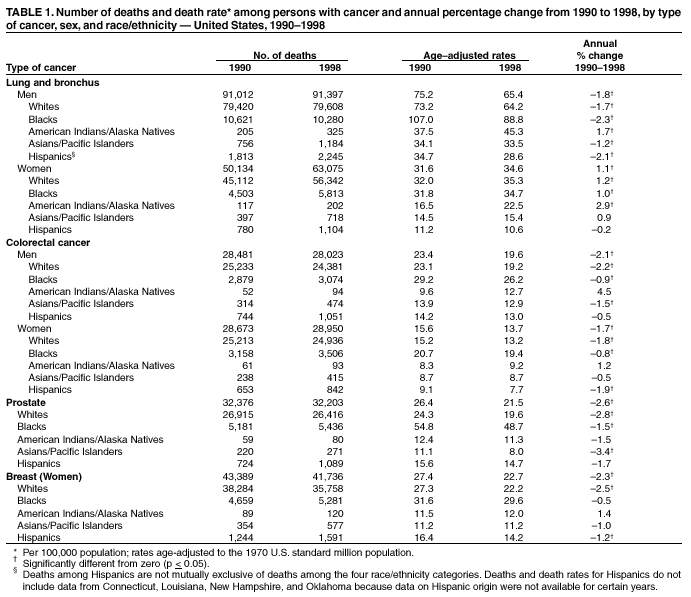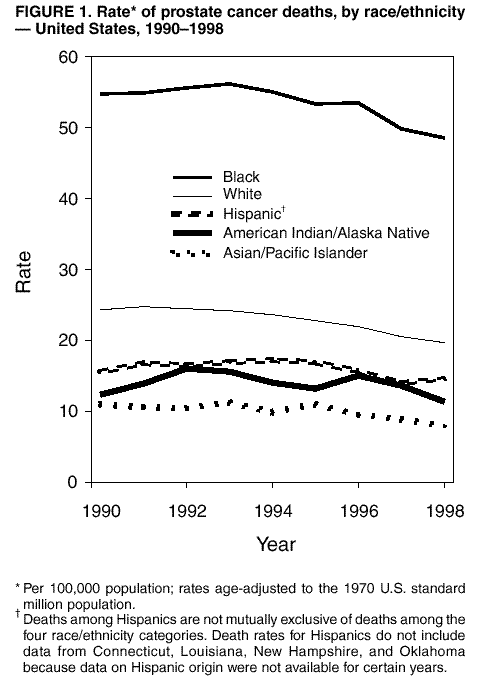 |
|
|
|
|
|
|
| ||||||||||
|
|
|
|
|
|
|
||||
| ||||||||||
|
|
|
|
|
Persons using assistive technology might not be able to fully access information in this file. For assistance, please send e-mail to: mmwrq@cdc.gov. Type 508 Accommodation and the title of the report in the subject line of e-mail. Recent Trends in Mortality Rates for Four Major Cancers, by Sex and Race/Ethnicity --- United States, 1990--1998In 1998, 53% of all cancer-related deaths in the United States were associated with four sites: lung/bronchus, colon/rectum, prostate, and female breast (1). Cancer-related death does not affect racial/ethnic populations similarly. In 1996, the National Cancer Institute (NCI) published cancer incidence and death rates during 1988--1992 in 10 categories of race/ethnicity (2). To examine trends during 1990--1998 in annual death rates for the four major cancers by sex and race/ethnicity (i.e., blacks, whites, Hispanics, American Indians/Alaska Natives [AI/ANs], and Asians/Pacific Islanders [APIs]), CDC analyzed data from the National Center for Health Statistics' National Vital Statistics System (3). This report summarizes the results of that analysis, which indicated that, except for lung cancer in women and lung, colorectal, and breast cancer in AI/ANs, trends in death rates from these cancers have generally declined. But the rates remained high for blacks, have not decreased equally among all populations, and have increased in certain instances. Continuing research and prevention efforts are needed to reach high-risk and underserved populations and to understand the reasons for differences in cancer mortality among racial/ethnic populations. In each state, attending physicians report and file causes of death on death certificates, which then are consolidated into the National Vital Statistics System. For this analysis, the International Classification of Diseases, Ninth Revision, (ICD-9) codes* for cause of death from these cancers and NCI software were used to compute death rates as the number of deaths per 100,000 population, age-adjusted to the 1970 U.S. population by using 5-year age intervals. Deaths and death rates were presented for 1990--1998 for whites, blacks, Hispanics, AI/ANs, and APIs. To test for significant trends in death rates during 1990--1998, linear regression was used to estimate the annual percentage change for this period. Data from 1998 indicated that death rates for lung and bronchus cancer were higher for blacks and whites than for other races/ethnicities (Table 1). Death rates for black men were higher than for white men. Among men, death rates from lung and bronchus cancer decreased 1% to 2% per year for each race/ethnicity except AI/ANs. Among AI/ANs, death rates increased 1.7% per year among men and 2.9% per year among women. Death rates also increased for white and black women. For 1998, death rates for colorectal cancer for each race/ethnicity were approximately 40% higher among men than women (Table 1). Blacks had the highest death rate for colorectal cancer, followed by whites. Death rates for colorectal cancer decreased 2.2% per year for white men and 1.8% per year for white women. Declines in death rates among black men and women were approximately 50% less than that for whites. Death rates for colorectal cancer increased 4.5% per year for AI/AN men, although the increase was not significant because of year-to-year variations in rates. Death rates for prostate cancer were more than twice as high for blacks than for whites (Table 1). Rates were lowest among APIs. Death rates decreased for men of each race/ethnicity except AI/ANs (Table 1, Figure 1). The declines in death rates for whites (2.8% per year) and APIs (3.4% per year) were approximately twice the decreases for blacks, Hispanics, and AI/ANs. Female breast cancer death rates were highest for blacks, followed by whites, Hispanics, AI/ANs, and APIs (Table 1). During 1990--1998, breast cancer-related death rates decreased for white (2.5% per year) and Hispanic (1.2% per year) women and were unchanged for black, AI/AN, and API women (Table 1, Figure 2). Reported by: P Gargiullo, PhD, PA Wingo, PhD, RJ Coates, PhD, TD Thompson, Div of Cancer Prevention and Control, National Center for Chronic Disease Prevention and Health Promotion, CDC. Editorial Note:The findings in this report indicate that death rates have declined for lung and bronchus, colorectal, prostate, and female breast cancers among most racial/ethnic populations; however, death rates remained high for certain cancers among blacks and are generally increasing among AI/ANs. Trends in cancer death rates might reflect changes in cancer risk behaviors, new screening modalities, and the development and use of new and more effective treatments (1). Lung and bronchus cancer was the most important cause of cancer mortality in the 1990s, accounting for approximately 28% of all cancer-related deaths (1). Approximately 90% of these deaths have been attributed to smoking (4,5). Changes in death rates reflect substantial decreases in smoking during 1965--1985 among men (51.9% to 32.6%) and smaller decreases among women (33.9% to 27.9%) (5). Increases in death rates for AI/ANs probably reflect increases in smoking rates. AI/ANs have among the highest smoking rates in the United States (6). Incidence of colorectal cancer among whites has been decreasing since approximately 1985 and has remained virtually unchanged for blacks, AI/ANs, APIs, and Hispanics. In the 1990s, decreases in death rates might relate to the increased use of chemotherapy and to screening and early detection (7). During 1987--1998, the percentage of persons aged >50 years who ever had sigmoidoscopy/proctoscopy increased from 24% to 38%. During 1992--1998, the percentage of persons in this age group who had had fecal occult blood testing within a 2-year period increased from 30% to 33% (7). Prostate cancer is second to lung cancer as a cause of cancer-related death among men. The gradual decreases in death rates for all the reported races/ethnicities during the study period might reflect aggressive treatment of advanced cancer and use of serum prostate-specific antigen (PSA) testing (1). However, the effectiveness of PSA screening and early-stage treatment in reducing mortality is unknown. Breast cancer accounts for the second largest proportion of cancer-related deaths among women (1). The recent increase in the incidence of breast cancer probably reflects greater use of screening and early detection because the increase has occurred mostly among women diagnosed with early-stage disease (1). By 1997, the percentage of women aged >40 years who reported having had a mammogram during the preceding 2 years was 72.9% for blacks, 72.5% for APIs, 71.4% for whites, 67% for Hispanics, and 59.9% for AI/ANs (8). The findings in this report are subject to at least two limitations. First, the reporting of race/ethnicity to the U.S. Bureau of the Census and on death certificates usually is reliable for blacks and whites (9); however, underreporting for other races/ethnicities can understate death rates from 2% among Hispanics to 21% among AI/ANs. Second, because this study was a description of national trends and not an evaluation of cancer intervention studies, the findings should be interpreted with caution. One of the goals of the national health objectives for 2010 is to eliminate health disparities among racial/ethnic populations. CDC supports several initiatives that address the four major cancers: national tobacco-control efforts; Screen for Life, a multimedia campaign promoting prevention and early detection of colorectal cancer; and Racial and Ethnic Approaches to Community Health (REACH 2010). CDC also funds research on the high death rates from prostate cancer among blacks and the National Breast and Cervical Cancer Early Detection Program, which provides screening to underserved women. Additional information about CDC's cancer prevention and control programs is available at http://www.cdc.gov/tobacco; http://www.cdc.gov/cancer; and http://www.cdc.gov/cancer/minorityawareness.htm. Differences in cancer death rates result from a combination of factors such as behaviors (e.g. smoking and nutrition); access to preventive, diagnostic, therapeutic, and screening services; and aggressiveness of treatment. If these factors were modified, more than half of the cancer deaths could be prevented and most racial/ethnic disparities in cancer death rates could be eliminated. References
* Codes: lung and bronchus 162.2--162.5, 162.8--162.9; colon and rectum 153, 154.0--154.1, 159.0; prostate 185; breast 174.
Table 1  Return to top. Figure 1  Return to top. Figure 2  Return to top.
Disclaimer All MMWR HTML versions of articles are electronic conversions from ASCII text into HTML. This conversion may have resulted in character translation or format errors in the HTML version. Users should not rely on this HTML document, but are referred to the electronic PDF version and/or the original MMWR paper copy for the official text, figures, and tables. An original paper copy of this issue can be obtained from the Superintendent of Documents, U.S. Government Printing Office (GPO), Washington, DC 20402-9371; telephone: (202) 512-1800. Contact GPO for current prices. **Questions or messages regarding errors in formatting should be addressed to mmwrq@cdc.gov.Page converted: 1/24/2002 |
|||||||||
This page last reviewed 1/24/2002
|